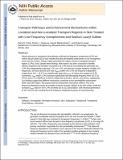Transport Pathways and Enhancement Mechanisms within Localized and Non-Localized Transport Regions in Skin Treated with Low-Frequency Sonophoresis and Sodium Lauryl Sulfate
Author(s)
Polat, Baris E.; Figueroa, Pedro L.; Blankschtein, Daniel; Langer, Robert
DownloadBlankschtein_Transport pathways.pdf (1.125Mb)
OPEN_ACCESS_POLICY
Open Access Policy
Creative Commons Attribution-Noncommercial-Share Alike
Terms of use
Metadata
Show full item recordAbstract
Recent advances in transdermal drug delivery utilizing low-frequency sonophoresis (LFS) and sodium lauryl sulfate (SLS) have revealed that skin permeability enhancement is not homogenous across the skin surface. Instead, highly perturbed skin regions, known as localized transport regions (LTRs), exist. Despite these findings, little research has been conducted to identify intrinsic properties and formation mechanisms of LTRs and the surrounding less-perturbed non-LTRs. By independently analyzing LTR, non-LTR, and total skin samples treated at multiple LFS frequencies, we found that the pore radii (r[subscript pore]) within non-LTRs are frequency-independent, ranging from 18.2 to 18.5 Å, but significantly larger than r[subscript pore] of native skin samples (13.6 Å). Conversely, r[subscript pore] within LTRs increase significantly with decreasing frequency from 161 to 276 Å and to ∞ (>300 Å) for LFS/SLS-treated skin at 60, 40, and 20 kHz, respectively. Our findings suggest that different mechanisms contribute to skin permeability enhancement within each skin region. We propose that the enhancement mechanism within LTRs is the frequency-dependent process of cavitation-induced microjet collapse at the skin surface, whereas the increased r[subscript pore] values in non-LTRs are likely due to SLS perturbation, with enhanced penetration of SLS into the skin resulting from the frequency-independent process of microstreaming.
Date issued
2010-08Department
delete; Massachusetts Institute of Technology. Department of Chemical EngineeringJournal
Journal of Pharmaceutical Sciences
Publisher
Wiley Blackwell
Citation
Polat, Baris E., Pedro L. Figueroa, Daniel Blankschtein, and Robert Langer 2011Transport Pathways and Enhancement Mechanisms Within Localized and Non-localized Transport Regions in Skin Treated with Low-frequency Sonophoresis and Sodium Lauryl Sulfate. Journal of Pharmaceutical Sciences 100(2): 512–529.
Version: Author's final manuscript
ISSN
0022-3549
1520-6017